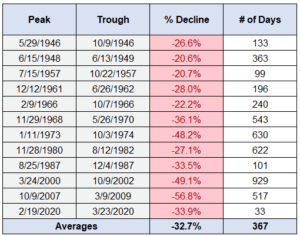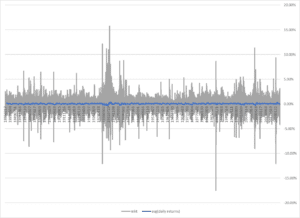Earlier this year I wrote quite a bit about the stock market as it was beginning to decline and enter a bear market. I wrote about what it means for investors and how to think about market declines. I’ve since taken a few months off from the topic because I haven’t had more to say, but I figure it’s time again for a quick check-in on the stock market to see where things stand.
It’s been a volatile year for the U.S. stock market. Here’s a look at the broad movements so far:

Most people can handle some level of volatility as long as the market is trending upwards, but as I’m writing this at the end of September, the S&P 500 is down around 22% on the year.
Not a great year for stock returns! In fact, if the 22% decline holds until the end of the year, it would make it the 6th worst calendar year return of the last 95 years.

The volatility combined with the downward trend prompts many to ask if there is precedent for this. Is this normal or is the stock market different now than it ever has been before?
The short answer is yes, there is precedent.
These are all of the bear markets since World War II:

I think it’s important to take into account how long each bear market typically lasts. We were spoiled in 2020 with a fast drawdown and a lightning-fast recovery, but the average bear market lasts for a little over a year.
There is also precedent for the volatility we’ve been experiencing. The following graph shows the daily market returns dating all the way back to 1885:

As you can see, the stock market is generally crazy and moves up and down a lot. Looking solely at the historical data, you can’t make the claim that recent volatility is substantially different from any other period in the U.S. market.
If anything, you could make the argument that it’s surprising the market isn’t down more.
Inflation is at 40-year highs. Interest rates continue to rise at the fastest pace in history—more than doubling since last year. It sure seems like the Federal Reserve officials are rooting for the stock and housing markets to crash to try and curb said inflation.
Yet, the S&P 500 is down just 22% from its all-time highs. That’s not even close to the average bear market decline of 33%. Yes, the market could drop further. But maybe it won’t.

Every bear market and recession is unique in its own way. This one is unlike anything we’ve seen before when you throw in the pandemic, government spending, interest rates, supply chain issues, etc. So yes, this time is seemingly almost always different, yet historical data suggests that things are typically always the same: chaotic and volatile.
Of the 12 unique and very different bear markets since World War II, every single one has eventually recovered and given way to a bull market.
Bear markets are painful. There’s no getting around it, even if you’ve experienced a few in the past. But with a long-term outlook, you can actually look at times like this as an opportunity.

The S&P 500 is down 22%. The Russell 200 is down almost 30%. The Nasdaq is down more than 30%. Stocks are on sale.
In 2035, when having a conversation with your friends about investing, someone is almost bound to say, “Man, can you believe where you could have bought stocks in 2022?”
Thanks for reading!

